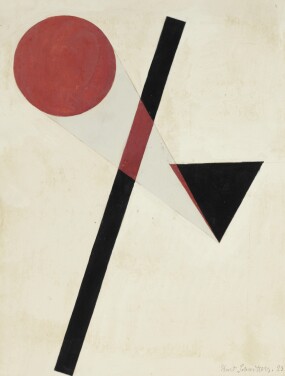Works by Kurt Schwitters at Sotheby's
Kurt Schwitters Biography
Kurt Schwitters was an experimental German artist in the early decades of the 20th century who embodied the spirit of the European avant-garde. His work is distinctly Modernist, although it is nearly impossible to narrow his career to a specific movement, as he worked in the styles of Constructivism, Dada and Surrealism, and used a wide range of media including collage, painting, sculpture and installation art. Adding to his importance, the trajectory of his career in many ways exemplifies the difficulties numerous German avant-garde artists faced as a result of the rise of Nazism in the 1920s and 1930s.
Born in Hanover, Germany, in 1887, he studied at the Dresden Academy, although he was unaware of the styles or works of the Die Brucke artists developing in Dresden at the time. Upon his return to Hanover in 1915, Schwitters began to work in Post-Impressionist, Cubist, and Expressionist styles, and his works became increasingly dark in tone as World War I loomed. He was exempt from military service during the war due to epilepsy; however, he worked as a draughtsman in a machine factory, which would influence his later conceptualization of industrialization in his work. After the war, he became involved with the der Sturm journal and gallery space, which brought him into contact with Raoul Hausmann, Hannah Höch, Hans Arp and other leading figures of the Dada movement. In the late teens, Schwitters began producing his “Merz” objects, for which he was perhaps best known at the time; consisting of collage, photomontage constructions of discarded pieces of his own works on paper, ephemera used by himself or friends, or fragments of found objects, Schwitters often, but not always, found his materials in dumpsters or general refuse piles. The “Merz” were ever expanding, and eventually turned into “Merzbau” rooms that occupied interior gallery and private living spaces, functioning as some of the first installation works of the 20th century. His use of discarded items gave the objects a second or third life, a critical innovation of the Dada period, which criticized contemporary materialism in the wasteful society of Weimar Germany between the wars.
When the Nazis came to power, they labeled Schwitters a “degenerate artist,” forcing him to flee to Oslo, until the Nazi invasion of Norway, which saw the burning of his Merzbaus as he fled. After a period of internment at a camp on The Isle of Man, he eventually settled in the United Kingdom where he died in 1947 while working on his final Merzbau, which was funded by the Museum of Modern Art, New York. Schwitters’ works have been reconstructed across Europe since his death, and later artists, including Robert Rauschenberg and Ed Ruscha, have credited Schwitters as a major inspiration. His works have garnered admiration from collectors and galleries around the world, and his objects occupy the permanent collections of many major institutions, including the Museum of Modern Art, New York, the Tate Gallery, London, and the National Gallery of Art, Washington, DC.












